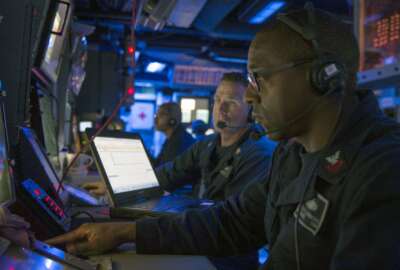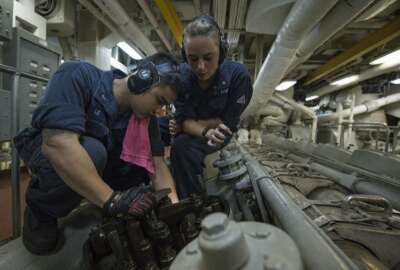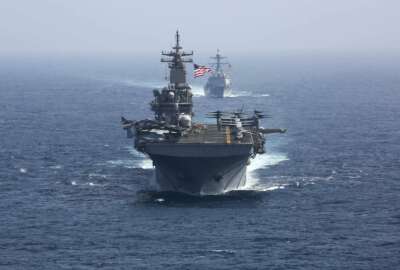
Engineering expeditions can be rewarding
Moving ships and submarines from point A to point B requires a careful ballet of many interconnected systems. Behind those systems are engineers.
Best listening experience is on Chrome, Firefox or Safari. Subscribe to Federal Drive’s daily audio interviews on Apple Podcasts or PodcastOne.
Moving ships and submarines from point A to point B requires a careful ballet of many interconnected systems. Behind those systems are engineers. They don’t work in obscurity. In fact, the Naval Facilities Engineering Systems Command Atlantic has named it’s 2021 Engineer of the Year. Charles Bolt joined Federal Drive with Tom Temin for more information.
Interview transcript:
Tom Temin: Mr. Bolt, good to have you on.
Charles Bolt: Good to be here, Tom.
Tom Temin: Tell us what the Naval Facilities Engineering Systems Command exactly does, let’s start there.
Charles Bolt: Well, the Naval Facilities Engineering Systems Command, as it’s now known, is basically the acquisition and tech authority for all the Navy shore facilities throughout the world. So we support our warfighters here in the United States as well as other system commands around the world.
Tom Temin: So this would be facilities where ships come into and go out of, I imagine?
Charles Bolt: So the word facility as I’m using it is basically a building or structure that supports the warfighter, whether it be a hanger, command facility, a pier or wharf or something similar to that.
Tom Temin: And what is your particular role in all of this?
Charles Bolt: So my role is an electrical engineer in electrical design branch here at NAVFAC Atlantic. Most of my work involves supporting design and construction efforts in the European theatre – Italy, Spain and Greece. And lately that’s included a number of complex critical communication centers that support our warfighters in the European Central and Africa commands.
Tom Temin: Interesting. So these are telecommunication systems or electrical systems, or maybe a hybrid of both?
Charles Bolt: Basically facilities or buildings that support voice and data, satellite communications between different entities in that theatre, yes.
Tom Temin: And what if any of the differences between designing a system, say that might operate in a place like Italy, or Greece, versus one that might operate here in the United States?
Charles Bolt: It’s kind of a complex dance that we do. When we do design work in the European Theatre, we typically work with a host nation consultant, and then joined with them. We work with the command over there. And because it’s a complex system of different codes, standards, criteria and requirements for whatever post nation country we’re working in.
Tom Temin: I imagine the voltages, the current levels, and so forth, and frequencies are different over there. Yet, you have to conform to what the Navy is using worldwide. So sounds like there’s a lot of mixing and matching and, sort of compensating that might have to go into these designs.
Charles Bolt: Yeah, there is a lot of complexity to it. But typically, overall, even though we’re designing and building facilities and a different country, we use, not the US standards but we design the facility that eventually in the end, if they ever do get turned over to the host nation, then they’ll be accredited for use with all their standards and codes.
Tom Temin: And where do the requirements get generated that get handed to you for these design projects?
Charles Bolt: The requirements are complex and basically we use unified facilities criteria and unified facilities guide specs that we have developed. But we also have to use industry standard and commercial codes and standards as well.
Tom Temin: And does most of your work involves staring at a screen all day using a mouse or do you have some interaction with the people who might actually be ending up using the facilities?
Charles Bolt: The majority of our work is office-based, computer-based. But we also, and I think I speak for most people, look forward to times when we do have to collaborate with people in certain areas. So there is some sort of travel and interaction involved with most of our designs.
Tom Temin: And of course, there’s the translation from the design to the construction of the hard wiring and so on. Do you go over perhaps to those countries to make sure it all works as you hoped it would?
Charles Bolt: Yeah, there’s the typical process involves designing the facility and then putting it out for bid. And then the construction process usually ends with certification and commissioning of all the complex systems involved and eventually, a turnover to the activities where it’s been constructed.
Tom Temin: We’re speaking with Chuck Bolt, he’s the Naval Facilities Engineering Systems Command Atlantic’s 2021 Engineer of the Year. And when you’re not working directly on Navy projects, I understand you spend quite a bit of time mentoring up and coming younger engineers. Tell us more about that.
Charles Bolt: Yeah, so I’ve been with NAVFAC for about 20 years now and in the month of December, it’ll be 20 years. I’ve seen people come and go of course, retiring, taking other assignments at our other commands. We do have new people come in all the time. We have a real need and desire to bring these people up to speed with their technical knowledge and their ability to navigate this very complex system of criteria and codes. So what we typically do is have a senior person assigned to the younger engineers that kind of lead them through and get them involved with a project and collaborating with other disciplines in that project.
Tom Temin: And do the projects, mostly these days a matter of cobbling together standard parts and subsystems, or do you sometimes have to add a resistor here, or change a voltage there?
Charles Bolt: Typically, they’re straightforward but involve many different disciplines, architecture, structure, civil, mechanical fire protection. So we typically work as a team to put an entire facility together.
Tom Temin: And is your deliverable, a schematic then, basically?
Charles Bolt: Our deliverable is a construction contract, which basically includes two components, a set of drawings and a specification that’s in a text format.
Tom Temin: Got it. And how did you get into this type of work? Were you the kind of kid that got a soldering iron for Christmas and was happy about it?
Charles Bolt: I don’t know about the soldering iron. But I’ve always been kind of a tinkerer. And I started off personally with going to at vo-tech-type school during high school, and then on to an electrical engineering program in college.
Tom Temin: Got it, so you’ve seen a lot of change in the whole field. And how do you keep up with the latest in terms of electronics and engineering principles?
Charles Bolt: Well, I tell you, it’s tough to keep up. And the electrical – one thing I think that makes electrical engineering so desirable to me is that it is always changing. As soon as you think you know what you’re doing, you are faced with new technology and new ways to design it. And I myself, try to stay involved with telecommunications societies and lighting societies in general to focus on new products and new technologies.
Tom Temin: I wanted to ask you about that, you’re also into lighting design. Is that a Navy pursuit or something you do as a kind of a hobby?
Charles Bolt: My lighting design work is kind of like a special interest. I started in kind of like the onset of my career. I’m a past president of the local Illuminating Engineering Society. And for me, it’s kind of exciting ’cause mostly, the electrical engineering design doesn’t involve a whole lot of artistic, creative elements. And doing lighting design gives me that ability to be creative, in an otherwise not so creative world.
Tom Temin: Now you have been named 2021 Engineer of the Year for the command in Atlantic. Now you go on, and there’s the possibility of being the national Naval Facilities Engineering Systems Command engineer of the year?
Charles Bolt: I believe that’s the process, but I’ll be honest with you, I’m not too familiar with the process of what happens after this.
Tom Temin: Well, if that’s the way it works, we wish you luck. Chuck Bolt is the Naval Facilities Engineering Systems Command Atlantic Engineer of the Year. Thanks so much for joining me.
Charles Bolt: Thank you, Tom. I appreciate the opportunity.
Tom Temin: We’ll post this interview along with a link to more information at FederalNewsNetwork.com/FederalDrive. Hear the Federal Drive on your schedule. Subscribe at Apple Podcasts or wherever you get your shows.
Copyright © 2025 Federal News Network. All rights reserved. This website is not intended for users located within the European Economic Area.
Tom Temin is host of the Federal Drive and has been providing insight on federal technology and management issues for more than 30 years.
Follow @tteminWFED





